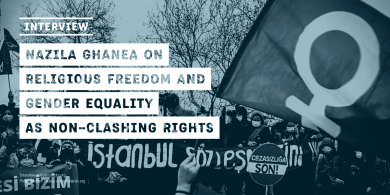“A Guide to Monitoring the Gender Dimension of FoRB” is published!

The guide aims to provide basic guidance on monitoring the gender dimension of freedom of religion or belief.
TO ACCESS THE GUIDE PLEASE CLICK HERE
Human rights violations that occur at the intersection of gender equality and the freedom of religion or belief impact countless individuals and manifest themselves in a wide range of situations. Many such violations may be condoned in the name of neutrality or religion or defended as “manifestations” of religion. Human rights, including the right to freedom of religion or belief, of women and girls, men and boys and LGBTI+ may, at times, be restricted because of stereotyped perceptions of religion or belief and gender.
A holistic approach mandates, not least, a focus on the gender dimension of freedom of religion or belief, the impact of religion and acts presented as manifestations of religion or belief on human rights, and gender equality. However, the gender dimension of monitoring, while critical, is easily overlooked because the monitoring methodology is often assumed to be “gender neutral”. Yet, the gender perspective should be integrated into the entire monitoring process. This process includes interviewing, media monitoring, collecting information on legislative, judicial and practical developments – reporting and seeking corrective action.
Integrating a gender perspective into human rights monitoring:
- helps to ensure that all violations against men and women of all ages and sections of society are recognized and accounted for;
- helps to make the experiences and concerns of women, girls, men, boys and LGBTI+ persons an integral dimension of the design and implementation of the monitoring activity;
- deepens understanding of causes and types of human rights violations and, hence, measures required for prevention and protection.
“A Practical Guide to Monitoring the Gender Dimension of Freedom of Religion or Belief” provides:
- an introduction to key concepts,
- a general overview of the applicable international human rights law standards,
- a brief discussion on overarching issues and,
- sets of illustrative questions that could support human rights monitors as they integrate the gender dimension into processes of systematic monitoring of the components of both the right to freedom of religion or belief and key complementary rights.
The guide aims to be a resource for those who work on monitoring and reporting on human rights, including activists, experts, advocates and journalists who report on these issues.




